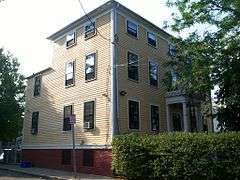Margaret Fuller House
|
Margaret Fuller House | |
|
Margaret Fuller House. | |
  | |
| Location | Cambridge, Massachusetts |
|---|---|
| Coordinates | 42°21′52″N 71°5′53″W / 42.36444°N 71.09806°WCoordinates: 42°21′52″N 71°5′53″W / 42.36444°N 71.09806°W |
| Built | 1810 |
| Architectural style | Federal |
| Part of | Old Cambridgeport Historic District (#83000820) |
| NRHP Reference # | 71000686[1] |
| Significant dates | |
| Added to NRHP | July 2, 1971 |
| Designated NHL | May 30, 1974 |
| Designated CP | June 30, 1983 |
The Margaret Fuller House was the birthplace and childhood home of American transcendentalist Margaret Fuller (1810–1850). It is located at 71 Cherry Street, in the Old Cambridgeport Historic District area of Cambridge, Massachusetts, now called the "Area Four" Neighborhood (north of Mass. Ave., between Central and Kendall Squares). The house is now a National Historic Landmark.
The three-story, wooden, Federal style house was built in the early 19th century, and was Fuller's home from birth until age 16. In 1902 it became the Margaret Fuller House of Cambridge, a settlement house providing information and services to help immigrants assimilate into American culture. It is now known as the Margaret Fuller Neighborhood House.
History
Fuller's parents, Timothy Fuller and Margaret Crane Fuller, were married in 1809. A few months after the wedding, they bought the three-story, Federal-style house on Cherry Street for the high price of $6,000.[2] The couple's daughter Sarah Margaret Fuller was born in this home on May 23, 1810.[3]
Current use
Today, the Margaret Fuller House is being used to service the public in the community of Area 4 in Cambridge. It provides a free computer lab, computer classes, a food pantry, after-school services for children, meeting room space for various activities for the public and a daytime summer camp for children. A fundraiser is held every year for the MFNH called the Sweet Soul Supper to help provide money to run these services.
The house was designated a National Historic Landmark in 1974 for its association with Fuller, whose publication of Woman in the Nineteenth Century in the 1840s has been described by her biographer Karen Antony as "the first considered statement of feminism in this country".[4]
See also
- William Brattle House – Margaret Fuller also lived in this home in Cambridge later in her life
- List of National Historic Landmarks in Massachusetts
- National Register of Historic Places listings in Cambridge, Massachusetts
References
- ↑ National Park Service (2007-01-23). "National Register Information System". National Register of Historic Places. National Park Service.
- ↑ Von Mehren, Joan. Minerva and the Muse: A Life of Margaret Fuller. Amherst: University of Massachusetts Press, 1994: 10. ISBN 1-55849-015-9
- ↑ Blanchard, Paula. Margaret Fuller: From Transcendentalism to Revolution. Reading, Massachusetts: Addison-Wesley Publishing Company, 1987: 15. ISBN 0-201-10458-X
- ↑ "NHL nomination for Margaret Fuller House" (PDF). National Park Service. Retrieved 2015-02-25.
External links
| Wikimedia Commons has media related to Margaret Fuller House. |

